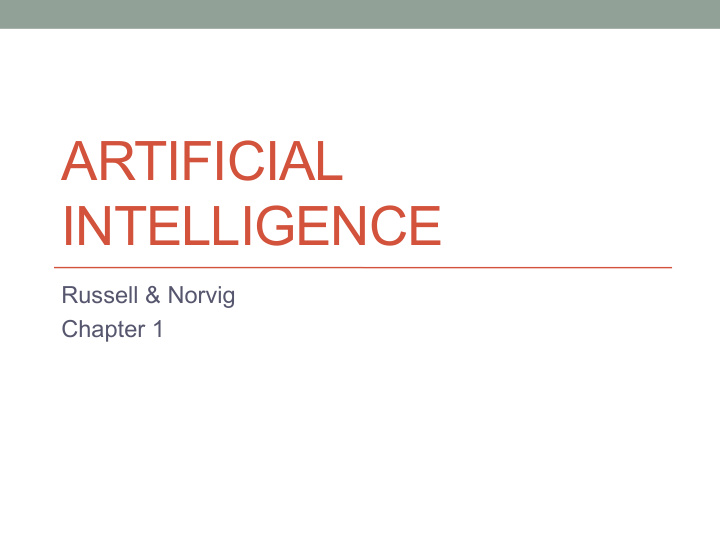



ARTIFICIAL INTELLIGENCE Russell & Norvig Chapter 1
What is AI? Human Rational Think Cognitive Modeling Laws of Thought/Logic Act Turing Test Approach Rational Agent Approach
Acting Humanly • Turing Test Approach (Alan Turing, 1950) • “Can machines think” à “Can machines behave intelligently” • Human interacting with two entities • How long to tell which is which? How reliable? • Avoids physical contact
Acting Humanly, continued • Turing predicted by 2000 a machine would have 30% chance of fooling a lay person for 5 minutes • He anticipated all major arguments against AI in following 50 years • Suggested major components of AI: • Natural Language Processing • Knowledge Representation • Automated Reasoning • Machine Learning • Total Turing Test includes Vision and Robotics • Loebner prize, chatterbot, annual since 1990 • http://en.wikipedia.org/wiki/Loebner_Prize
Thinking Humanly • Cognitive modeling • First problem – how do humans think? • Introspection: catch our own thoughts • Psychological experiments: observing people • Brain imaging • Newell & Simon’s General Problem Solver, 1961 • Less interested in “correct” solutions • Wanted to compare trace to reasoning steps of human on same problems
Thinking Rationally • “Laws of Thought” approach, Logic • Direct line through math and philosophy to modern A • Aristotle’s Syllogisms • For example: • Socrates is a man man (Socrates) • All men are mortal ∀ x man(x) è mortal(x) • Then, Socrates is mortal è mortal (Socrates) • Encode (hard), create database, let inference system determine valid statements
Acting Rationally • Rational agent approach • Agent is something that (perceives and) acts • Rational agent is one that acts so as to achieve the best outcome (or best expected outcome, if uncertainty) • Should make correct inferences (as in Think Rationally) but also reason logically • Includes: • Inference (logic) • Reflex (hot stove, don’t deliberate) • Knowledge representation and reasoning • This is approach used in textbook
Foundations of AI Philosophy Logic, methods of reasoning, mind as physical system, foundations of learning, language, rationality Mathematics Formal representation and proof, algorithms, computation, decidability, tractability, probability Psychology Adaptation, perception and motor control, experimental techniques Economics Formal theory of rational decisions Linguistics Knowledge representation, grammar Neuroscience Mapping brain activity, models of nervous system Control Theory Stochastic optimal control
History of AI • Gestation of AI (1943-1955) • Birth of AI (1956) • Early enthusiasm, great expectations (1952-1969) • A dose of reality (1966-1973) • Knowledge-based systems: key to power (1969-1979) • AI becomes an industry (1980-present) • The return of neural networks (1986-present) • AI adopts the scientific method (1987-present) • Emergence of intelligent agents (1995-present) • Availability of very large data sets (2001-present)
AI: State of the Art examples • Robotic vehicles - driverless • Speech recognition • Autonomous planning and scheduling – NASA is leader • Game playing – IBMs Deep Blue (beat Kasparov, 1997) • Spam fighting • Logistics planning – DARPA is leader • Robotics – Roomba, hazardous materials • Machine translation – various languages
Recommend
More recommend